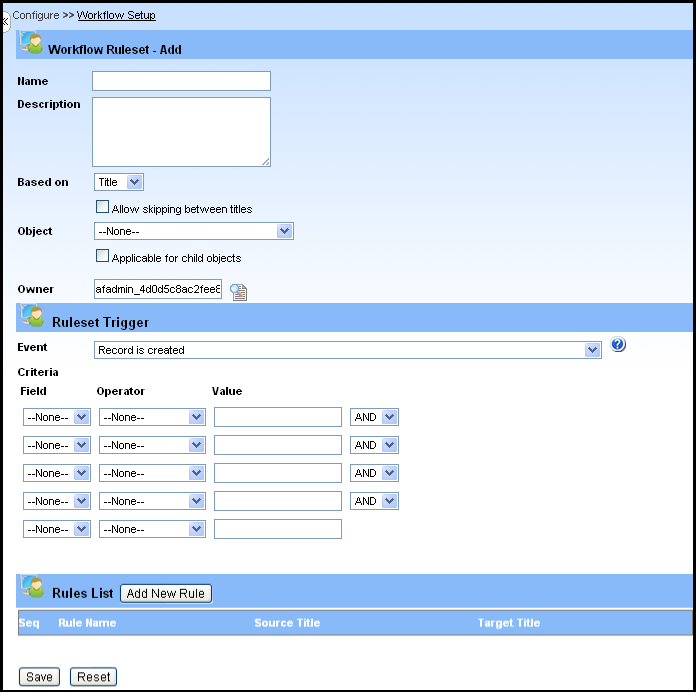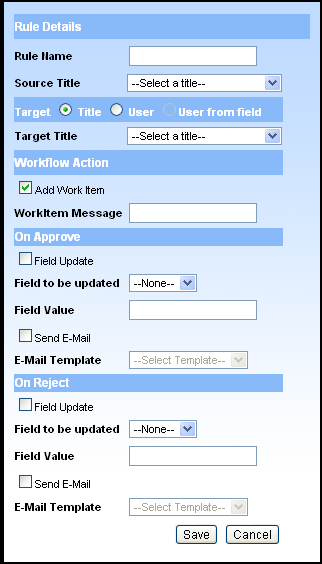Help
Overview
Getting Started
Using Easy-Commission Application
Rep
Master Data
Calculation Rules
Transactions
Calculation Process
Dashboard
Commission Statements
Period Close
Year End
Configuring Easy-Commission Application
User Setup
Appendix
Help
Overview
Getting Started
Using Easy-Commission Application
Rep
Master Data
Calculation Rules
Transactions
Calculation Process
Dashboard
Commission Statements
Period Close
Year End
Configuring Easy-Commission Application
User Setup
Appendix
Workflow is the automation of a business process, during which data are passed as work items from one user to another according to a set of rules defined in the workflow. Workflow can be created using Manage Workflow option and can be viewed using Workflow History option.
This page creates and maintains the workflow Ruleset. Administrator can enter the rule set details manually in this page. The Manage Workflow menu lets you quickly create and view details. In addition, this menu lets you to edit, delete and copy details.
You can click Configure ? Manage Workflow menu item to display the "Manage Workflow" page. This page will list all the Name, Description, Links to Edit, Delete, Copy option. From this page, you can view detailed workflow rules and access other related information.
Definition of Workflow terminology
Workflow Ruleset: Defines the type of workflow such as User based or Title based and Object that should trigger the workflow.
Ruleset Trigger: Defines the initiation criteria to trigger the workflow.
Event: An instance that occurs on an object to trigger the workflow
Criteria: Defines the Condition that triggers the Workflow
Workflow Rule: Rules that defines the flow of tasks from one user to another and the action to be done on every approval or reject
Workflow Item: Work to be processed by the user
Workflow Ruleset is the rule defining the event, and criteria to trigger the workflow for the users. Two different types of workflow can be set - User Based, and Title Based.
User Based Workflow - To define a Workflow based on the users
Title Based Workflow - To define a Workflow based on Title maintained in Organisation Structure.
Workflow Item is the representation of the work to be processed. The Workflow Item can either be approved or rejected by the workflow user.
Workflow Status: Draft, In Workflow, Rejected and Approved
Creating a New Workflow Ruleset
Admin user can create a new Workflow Ruleset and its description. You have to follow the steps given below to add new menu "Emp Master" under the Menu "Samples" using the pageset" Emp Master".


? Record is created - Workflow gets triggered when a record is created in the selected object, that is, Emp Master
? Record is created or updated - Workflow gets triggered when a record is created or updated in the selected object, that is, Emp Master
? Record is created or updated, with single trigger - Workflow gets triggered only once for a record either on its create or update in the selected object, that is, Emp Master
? Record is created or updated, trigger when no action is pending - Workflow gets triggered for a record create or update, only when no action like Approve or Reject is pending for that record
? Record is created or updated, with single trigger for each level ? Workflow gets triggered when a record is created in selected object, that is, RFA Header. Here, all pending Workitem pertaining to that record will be replaced with appropriate message saying 'Work item cancelled due to re-submission' except for user's immediate reporting to person, for whom existing Workitem will be overwritten.
? Record is created, or updated by the owner of the record - Workflow gets triggered when a record is created, or updated by the owner of the record. Owner is the user who created that specific record.
? Record is created, or updated by the owner of the record, with single trigger for each level - Workflow gets triggered when a record is created, or updated by the owner of the record. Owner is the user who created that specific record. If any action is pending, those actions will be notified and closed.
Here, the option "Record is created or updated, with single trigger" is selected.

? For Title based Workflow, select the target option as "title", you can select the title from the Target Title drop-down.
? For User based Workflow, select the target option as "user", you can select the user from the Target User drop-down.
? When target user should be fetched from particular fields then select the option as "user from field", you can select the field from the Target Title drop-down.
Here, select Title option and Target title as "Sales Manager".
Note:
Note:
Workflow Item page maintains the list of work items that are created when the user submits the task. The higher authority in the Organisation Structure can approve or reject the task or work item. If the work item is rejected, the subordinate (Say "Sales Rep") can view the rejected work items in this page. However, the higher authorities cannot view their approved work items in this page. The higher authorities and their subordinates can view their history of work item in the Workflow Item History page.
To approve or reject the workflow item, do the following:
To view the rejected workflow item, do the following:
Workflow History
All users can view their workflow details (Submitted, Completed, Approved and Rejected) in the Workflow History.
To view the Workflow history, do the following: